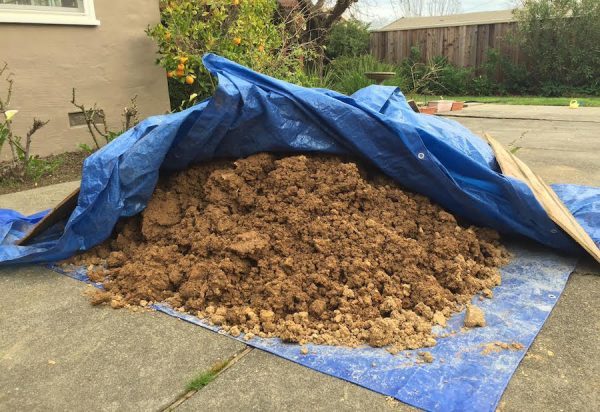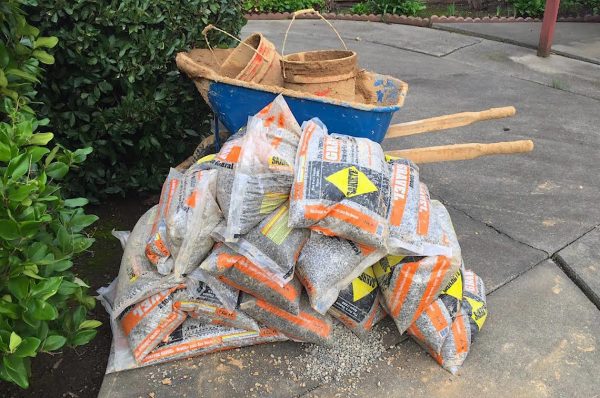My family and I moved into our home at the height of the California drought, and before this winter, we’d never experienced any significant rainfall while living there. After a major storm system passed through in February, we checked the crawlspace and, to our dismay, found several inches of stagnant water beneath the house. The forecast called for more rain. As the water in the crawlspace continued to rise and fall with ongoing storms, we knew we had to do something. But what would be the best solution?
There are several options for preventing water saturation in your home. In this article, I’ll review some of them and share how we came to the decision to install a sump pump.

Installing a sump pump required removing a massive amount of dirt from the crawlspace. Photo: American Ratings Corporation (2017)
Check for mold
Before you can start on a water barrier plan, you need to check for and eliminate any mold. In a dark, humid crawlspace or basement, mold growth is a strong possibility. After spotting some blotchy areas on our walls, we contacted a remediation company and they isolated the mold with plastic and tape. After a few days, we could safely remove the coverings and put our furniture back in place. You can find more tips on remediation at www.diamondcertified.info/mold.
Dehumidifiers
A dehumidifier is a great solution for drying out an area that has been unexpectedly inundated with water. If your home has suffered a roof leak or burst pipe, a dehumidifier may be just what you need to reduce the possibility of further water damage or mold growth. In our situation, a dehumidifier wasn’t enough. As it rained, water kept seeping up from the ground into our crawlspace. A dehumidifier would help keep things dry, but it wouldn’t keep the water out.
Trench drains
Many homes in our neighborhood have trench drains—a special type of drain that diverts down-sloping rain from reaching your home. If you find that one side of your property is more affected by water than other areas, a trench drain may be your best option. In our case, water was seeping into multiple areas of our crawlspace, so we had to keep looking for an answer.
Vapor barriers
Many Bay Area residents opt to line their crawlspaces with a plastic barrier that keeps moisture from permeating the space beneath the home. Make sure the barrier is installed on the ground surface, not on the ceiling of the crawlspace. We planned to install a vapor barrier once the water cleared out, but we needed something that would take care of the standing water.
Sump pumps
These small devices remove water that accumulates in basements and crawlspaces. Sump pumps are relatively inexpensive, but the installation can be complicated, messy and costly. However, based on our troubles, we knew a sump pump was the best solution for keeping our home dry.
For the sump pump to operate, water needs to flow to the device before it can reach ground level. Our contractors began the installation by digging a trench around the perimeter of the crawlspace. Piles of damp dirt filled our backyard and driveway. A filtered pipe was placed in the trench and surrounded with gravel. This way, ground water (but not mud or debris) would collect in the pipe and flow to the sump pump. The contractors then dug a separate hole in the lowest part of the crawlspace for the crock or sump basin, which is a perforated bin that collects excess water and houses the sump pump. The level of the ground water had risen so high beneath our home that our sump basin needed 200 pounds of gravel to weigh it down and keep it from floating. The contractors then installed an evacuation pipe that would channel away the pumped water. Lastly, an electrician connected the sump pump to our home’s electrical panel.

It took more than 200 pounds of gravel to weigh down the sump basin in the groundwater beneath the house. Photo: American Ratings Corporation (2017)
Finding excess water in our home was stressful and identifying a solution was challenging. Even though the sump pump solution wasn’t the simplest—it meant coordinating multiple contractors and spending several weeks with a garden covered in mud—I’m confident it was the right one. I’ve always enjoyed the sound of rain on my roof. Now when it rains, there’s another sound I look forward to: the regular, gentle whir of the sump pump keeping my home dry.
To find a Diamond Certified company that can help you deal with water damage in your home, visit www.diamondcertified.info.
